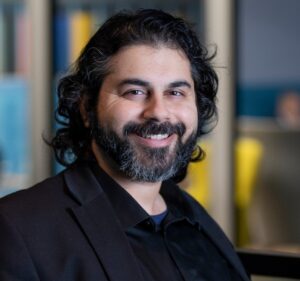
‘The last frontier of disruption’: With its new AI chatbot, EY teams seek to take the pain out of payroll questions
An employee in Hungary asked if having twins would impact his parental leave. A worker in Spain wondered whether the bonus of $20,000 euros she received would be taxed. Another employee asked what requirements he would have to abide by if he went to work in a United Arab Emirates country as a foreign national.
Those queries, received by clients of multinational professional services organization EY, underscore the complexity organizations worldwide face in trying to answer employees’ payroll questions. To address that challenge, the EY organization (previously named Ernst & Young) worked with Microsoft to create a generative AI chatbot that will be developed to answer payroll questions from employees across the 159 countries and 49 languages that EY clients encompass.
The chatbot, which leverages the Microsoft Cloud and ChatGPT in Azure OpenAI Service, uses a large language model (LLM) that analyzes information from pay slips, tax regulations and employer policies to provide answers to complex payroll questions — with the goal of increasing employee satisfaction and reducing costs for employers.

“Payroll touches employees more than any other function,” says Sheri Sullivan, EY global payroll operate leader. “Employees around the globe currently have a very poor experience when it comes to getting answers to their payroll questions. And employers struggle with that.”
Research has shown that employee attraction and retention are directly proportional to workers’ experiences on the job, Sullivan says. And pay is central to that, she says — not only the amount, but also employees’ perception that they are being paid fairly and understand payroll policies.
Payroll issues are complicated by myriad factors ranging from tax regulations that vary between countries and even local municipalities to employer policies and individual circumstances. The coronavirus pandemic exacerbated those complexities, Sullivan says, with the growth of remote work and its resulting impacts on payroll.
Organizations have traditionally handled payroll queries in several ways — through a designated individual, basic chatbots that can usually handle only rudimentary questions, traditional call centers, or in some cases, not at all, Sullivan says. The result is often an inefficient and costly system that leads to frustration for employees, who may simply give up before getting answers to their questions.
“Payroll is really, I like to say, the last frontier of disruption,” Sullivan says. “There’s been lots of investment in human capital management systems and finance systems and other back systems. But with payroll, there’s been limited investment for the past 20 years, because the technology hasn’t had the capabilities to deal with all the deviations and complexities within payroll.”

That’s changing with the emergence of generative AI capabilities. EY teams have been working closely with Microsoft for several years to help EY’s clients implement cloud-based solutions across various sectors. Addressing payroll questions has long been a challenge for EY member firms, Sullivan says, and as Microsoft moved to make ChatGPT available in Azure OpenAI Service in March 2023, EY teams saw an opportunity to address the issue.
EY teams began developing a proof of concept for the organization’s chatbot, uploading data from a range of sources into the bot and asking its payroll consultants in various countries to share questions employees had recently asked, then using that information to train its model.
“That is really at the heart of our IP,” says Ken Priyadarshi, EY global tax prompt engineering leader. “It’s going inside the heads of our practitioners and asking, ‘What are some of the really interesting ways clients might ask payroll questions that require a little bit more reasoning and thinking?’”

Azure OpenAI Service allows customers to run the same models as OpenAI, but with Azure’s security protocols. That will enable EY teams to deploy the chatbot across countries and regulatory environments, Priyadarshi says.
“For us, the differentiator was not only security but also tooling to work in a user-friendly, fast way,” he says. “Our developers were able to use Microsoft’s Azure OpenAI Service capabilities to build what I would call a private ChatGPT for payroll in collaboration with Microsoft very quickly.”
In internal testing, Sullivan says, the chatbot quickly answered questions in over 27 languages. EY teams are currently piloting the chatbot with clients to gauge employee satisfaction, cost to employers and the bot’s ability to accurately address questions in a single interaction. EY teams anticipate that the technology will be able to answer more than 80% of payroll questions and save employers over half the current costs of addressing those queries.
“There is interest from clients in the largest countries to be part of this pilot,” Sullivan says. “The interest is through the roof, because this is such a pain point for them.”
EY professionals and the organization’s clients are also excited when they see what the bot can do, Sullivan says. While some professionals are cautious about the technology or concerned about its possible impact on their jobs, she says the bot won’t replace them but instead free them up to review data, trends and outcomes, and make recommendations, “instead of doing the manual work to compile and process the data.”
Priyadarshi sees the promise of generative AI chatbots in what he terms “intelligent co-sourcing” — merging deep subject matter experience with large language models to provide information in a human, conversational way.
“We can train an LLM using a practice’s knowledge, and then help surface deep insights, and also support knowledge discovery using bots and copilots,” he says. “And that’s, I think, the future of this capability, not just for payroll, but for all kinds of knowledge worker practices.”
Top photo by Robert Daly/Caia Image. All photos courtesy of EY.

